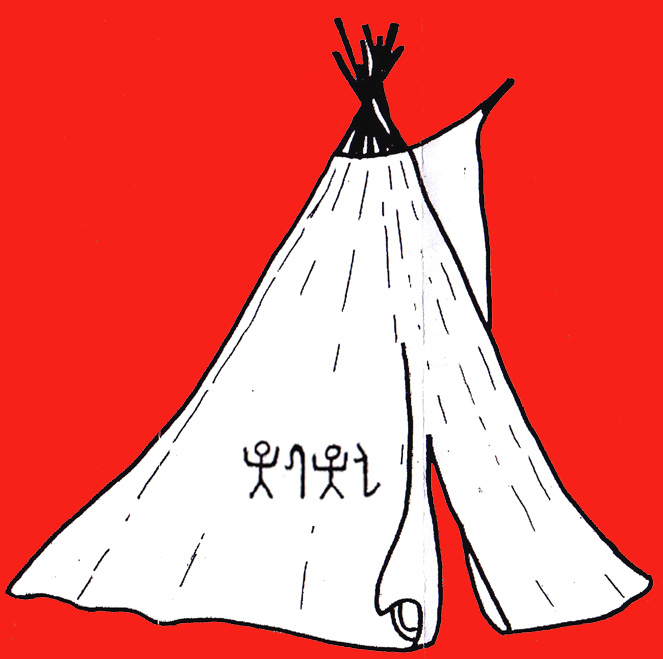
Calalus: Jews in Arizona in 775 A.D.
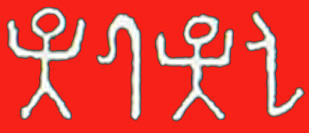
 |
Calalus: Jews in Arizona in 775 A.D. |
 |
|
Near Tucson Arizona is where the story began, a crew of laborers in 1884 were making a little roadside resting spot near Nine Mile Waterhole. In this area they came upon a couple of metal swords, which one of the laborers gave to his children, who in time lost them. Tucson laid in a section of Arizona that had become part of the territory of the United States in 1856, it was the territorial capital from 1867 to 1877. The railroad made it out there in 1880, causing more growth. The city grew rapidly after World War I doubling in size from 13,000 to over 26,000 in 1925. "A disabled veteran of World War I, Charles E. Manier, moved to Tucson in the early fall of 1920. Nearly four years later, on September 13, 1924, he, his wife, daughter, and elderly father had driven to see Picture Rocks and were on their way back when they stopped past Nine Mile Waterhole to inspect a typical roadside limekiln, the very one where (they were unaware) two swords had been turned up forty years before in the excavation preparatory to building it." Calalus by Cyclone Covey p. 74 Forty years of erosion in the path where the workers had cut through the kiln, left part of an object uncovered, protruding 3 inches from a 7ft. bank. Manier borrowed the metal-tipped cane from his father and tapped the object. It gave a dull metallic ring. He fetched a small army pick and spade from the vehicle and extracted what turned out to be a cross weighing 62 1/2 pounds. When taken home and washed in the presence of several of his neighbors, it proved to be a pair of crosses riveted together. When pried apart, the smooth inner surface was smeared with stinky wax, with the removal of the wax inscriptions could be seen on each face. "One neighbor thought it was Spanish, but Professor Kennison recognized it as Latin. Kennison's wife recommended Manier to Professor Frank Fowler of the university's College of Letters. "Fowler that same day began translating: 'We are carried forward on the sea.' The next word Calalus, he put question marks after, and then 'An unknown land/ A people widely ruling', then Toltezus, another question mark and so on." Calalus: p. 74, 75 "The lead swords, spears, fragments of swords and spears, patriarchal monstrance, and eight heavy crosses in the 1920's from beneath a centuries-undisturbed seal of 3 1/2 to more than six feet of cemented-like caliche over a hundred square foot area, had been strewn at random as if lying where they dropped during a final battle. "All eight crosses had been engraved -- seven with Latin letters and numerals and two with Hebrew words also, one of the latter included one Greek word. Six of the crosses are double, i.e. consist of paired halves, the smooth inner faces riveted against each other with a protective layer of wax between. Each pair of thus--concealed inner surfaces bore a Latin text; the double crosses had been manufactured for the sole purpose of permanent recording. "Beside the names of the kings, much else on the gun barrel blue to light-lead gray artifacts confirms the colony to have been Jewish: a menorah with seven burning candles, a pair of Hebrew goblet-chalices (habdalah), incense spoons, burning incense, numerals I to X in double column surely signifying the Ten Commandments, and words in carefully-drawn square Hebrew script, including shalom ("peace"), kadosh, qadash, and gaddash ("holy" or "He [or it] is holy"), elohim ("God"), goi gadol ("a great nation"), etc. The colonists evidently represented a heretical Jewish sect. Their central symbol of the cross, although not unknown to Jewish tradition, was atypical. Fred Horton, of the Wake Forest Department of Religion, recognized in 1971 that two of the crosses (artifacts 18 & 20) were nehushtans, which had ceased to be orthodox from the time king Hezekiah broke the one in the Temple that the people were burning incense to (see II Kings 18:4). That one was the staff with brazen serpent Moses purtedly had used as a snakebite-healing charm in the desert migration of the Children of Israel.'' Calalus: A Roman Jewish Colony in America from the time of Charlemagne through Alfred the Great p. 43 by Cyclone Covey YAHUSHUA Himself declared that the nehushtan was a symbol that was intended to point to Him. "As Mosheh lifted up the serpent in the wilderness, even so must the Son of man be lifted up: that whosoever believeth in Him should not perish, but have eternal life." John 3:14, 15 The thought did cross my mind that these Jews might have believed in the Messiah, and used the nehushtans for object lessons to help reach the Indians, one artifact did have an American Indian design on it, which seems to at least indicate some contact with the Indians. I don't have the space, time, and capacity to argue each point carefully, in favor of the artifacts. But Cyclone Covey of Wake Forest University out of Winston-Salem North Carolina did an excellent job in his book Calalus: A Roman Jewish Colony in America from the Time of Charlemagne Through Alfred the Great, a patriotic American who also wrote a book Roger Williams, the Gentle Radical. Cyclone successfully makes these blockers of knowledge and truth look pretty stupid. He argues the authenticity of the metal itself, the undisturbed caliche and the writings in Hebrew and Latin. Of course with any find, there is going to be alot of unanswered questions. The discoverers themselves said it would be impossible for a recent "planting" of the artifacts. Humanity should have learned a lesson long ago, when the common people were waiting for their religious leaders to announce YAHUSHUA to be the Messiah. We shall make the same mistake if we are going to wait for all the "approved academia" to pronounce all these artifacts and others to be genuine, or to tell us what truth is. You have a mind. So you'll have to use it and weigh the evidence for yourself. Don't let them push you around and dictate to you what is authentic or not.
|
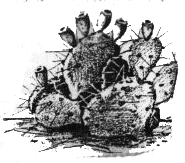 |
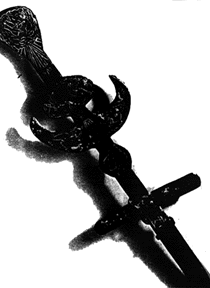 |
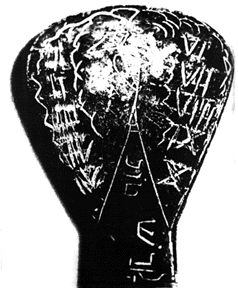 |
||
| Artifact 20 reverse. Shows clouds on knob (Ps 97:2) below nqh in Hebrew (He has acquitted), below heralding angles, below a faint rising thunderbird, which seems American Indian. Also shows a medieval crossing compass and a T-square on the left horn like that used in Freemasonry but omits the letter G.. Another Nehushtan at cross-arm. | Artifact 20,
obverse, Roman numerals 1 to X depicting the Ten Commandments, herald
angel, qadash ("he is holy") and tob ('good"), Photo: Evans Discovered near Tucson, Arizona, dating around 775 A.D. |
||
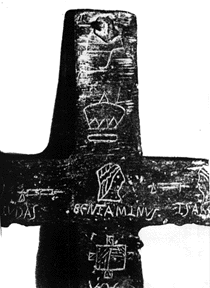 |
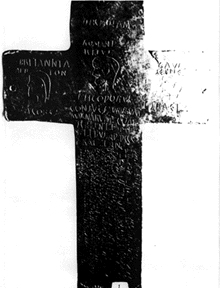 |
||
|
Artifact a Inscribed with IVDAS BENIAMINVS ISAAC |
Artifact 1a.
Inscribed with: Britiannia Romani Gavl Albion Actius Seine Iacobvs Theodorvs Israel |
||
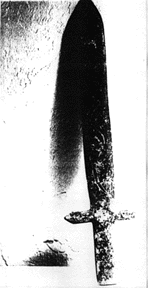 |
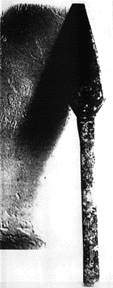 |
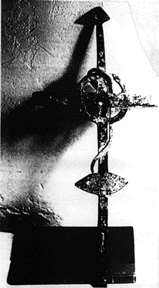 |
|
| A short sword. Artifact 12, showing "diplodocus" a dinosaur, probably and idea from Isaiah 27:1. And "field" design at cross bar. Photo: Evans | A spearhead. Artifact 10, showing incense spoon. Photo David Evens | Nehushtan. (see II Kings 18:4) a serpent wrapped around a cross. Artifact 18. Photo: Evans. | |